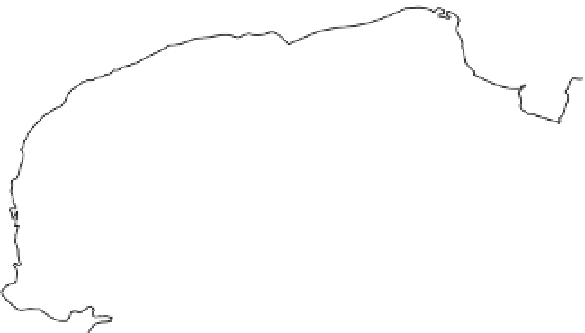Environmental Engineering Reference
In-Depth Information
(a)
SCHIERMONNIKOOG
AMELAND
TERSCHELLING
Groningen
Piet Scheve
Plaat
VLIELAND
Griend
Hengst
TEXEL
THE
NETHERLANDS
cockle-dredging in late 1980s
non-impacted control areas
Balgzand
0.4
(b)
(c)
Balgzand
Hengst
Griend
Balgzand
Hengst
Griend
0.0
1
Balgzand
Balgzand
Griend
-0.4
Piet Scheve Plaat
Groningen
Griend
-0.8
Piet Scheve Plaat
0.1
-1.2
-1.6
Cerastoderma edule
Macoma balthica
-1.8
0.01
Groningen
-2.2
NO
YES
Area dredged for cockles in late 1980s
NO
YES
Fig. 13.2
Comparison of spatfall of
Cerastoderma edule
(b) and
Macoma balthica
(c) just after the cockle-dredging
events in the 1988-90 period: average spatfall densities in 1992-4 and somewhat later in time (1996-8) on five
different intertidal flat areas in the Dutch Wadden Sea (a) that were either exposed or not to cockle-dredging. None
of the areas was dredged for cockles after 1990. Two of the areas (Griend and Balgzand) contained a fished and a
non-fished part and these data points are connected by dashed lines. For
Cerastoderma
the difference in log ratios
of fished and unfished areas was highly significant (separate-variance model,
t
= 5.720, df = 4.4,
P
= 0.003). The
long-term absence of high cockle densities in areas dredged for cockles appears to be a consequence of reduced
recruitment and a genuine effect of the mechanical cockle fishery. For the non-target species
Macoma
a difference
in settlement between fished and unfished areas could not be confirmed statistically. The direction of the difference
was the same as for
Cerastoderma
, but the power of our test was not large enough to show that the ratios for
fished areas were significantly lower than ratios for unfished areas (
t
= 2.053, df = 3.7,
P
= 0.116). From Piersma
et al.
(2001).
proportional to the degree to which the benthic
species were affected (C. Kraan, A. Dekinga and T.
Piersma, unpublished observations). Cockle-dredging
thus transforms rich benthic intertidal communities that
include the longer-lived bivalve and worm species
into much poorer communities that consist of small,
short-lived polychaetes and crustaceans.
In the 20th century intense oyster fishery in the
Wadden Sea led to the extinction of flat oysters
(
Ostrea edulis
; Reise 1982). This process has repeated
itself on the other side of the Atlantic, in Chesapeake
Bay, the largest estuary of the USA and a region that
shows many similarities to the Wadden Sea. In the
course of the past 100 years an important shellfish






































































































